When it comes to summer desserts, shortcake is probably at the top of everyone’s list. What’s not to love about tender pastry, sweet seasonal fruit, and whipped cream? It’s an American classic, and a perfect ending to any summer meal. Traditionally you use a biscuit as the base and topper for a shortcake, and I’m totally on board with this approach because it cuts the sweetness of the overall dessert. (Don’t get me started on “shortcakes” made with pound cake or angel food cake. I get a toothache just thinking about all that sugar.)
These biscuits are perfect for shortcake – tender and moist with just a hint of sweetness and spice, they’re sort of a scone-biscuit hybrid. They have enough structure to hold up to fillings and toppings but yield easily to a fork, and pretty much melt in your mouth. They’re obviously gluten-free since I’m me, but they also happen to be dairy-free, and they’re the bomb. Seriously, I served a winter version of this shortcake to a group of restauranteurs without telling them it was GF and vegan, and nary a crumb was left behind on their plates. I call that a win!
You’re likely accustomed to enjoying your summer shortcake with berries, and while I love a good berry shortcake, I’m always looking for an excuse to partake in the glorious bounty of seasonal stone fruits – particularly nectarines. There’s just something about their rich, aromatic flavor and firm texture that gets me every time. Their firmness also makes them terrific candidates for grilling, because they can take on some lovely grill marks and caramelization yet hold their shape beautifully. You’re welcome to substitute peaches for the nectarines, just make sure they’re pretty firm so they don’t turn to mush on the grill.
The final essential component of a shortcake is a whipped topping. If you can eat dairy, please feel free to use some barely sweetened whipped cream in these babies. For the rest of you, I’ve included instructions for making your own whipped coconut cream.
I could stop right there and the shortcakes would be delicious, but I can never leave well enough alone so there’s one more element to this fabulous dessert – a delicious ginger-hibiscus syrup. It’s tart and slightly sweet, with a little kick of heat from the ginger. The flavor pairs perfectly with the nectarine, and it makes for a beautifully vibrant color contrast drizzled over the cream and nectarines. Once you try this easy and delicious confection, you’ll want to serve it all summer long. Why not start by adding it to the menu for your Father’s Day celebration this weekend?
Ready to make shortcakes? Here we go!
Get started on the ginger-hibiscus syrup by steeping the petals (or tea bags) and ginger in hot water. Let that sit while you make the biscuit dough. (I personally make this dough in a bowl because my food processor is a pain to haul out and clean, but feel free to make your dough in the processor if you prefer.)
First thing you always do? Preheat the oven! Then sift your dry ingredients together, measure out your coconut oil, and get your liquids mixed in a measuring cup and ready to go.
Notice that my dry mix is darker than standard flour. In addition to the coconut sugar and cardamom, I use some buckwheat and almond flours in the mix and they’re both dark.
Add the coconut oil in chunks, and use a pastry cutter to work it all together until you have a coarse meal. If you’re using a food processor, *pulse* it into a meal (be sure not to let it run steadily – the friction will generate too much heat and melt the oil). Take a look at my mixture here – you want to cut in the coconut oil until you don’t see any large chunks of it; pea-sized or smaller is fine.
Now pour in your liquids, and blend with a fork or pulse in the processor until it all comes together.
You should end up with a sticky dough like this. You can still see individual bits of coconut oil (those white dots scattered throughout). This is a good thing – it means I didn’t melt the oil while mixing the dough.
Turn the dough out onto a floured work surface and sprinkle a little more flour on top, then fold it over itself a few times to work in the extra flour and bring it together. Pat the dough into a disc about one inch thick (it will be roughly 6 inches in diameter).
Line your baking sheet with parchment or a silpat and set it off to the side. Using a 2 ½ inch biscuit cutter, punch out biscuits as closely together as possible. Since the dough is a bit sticky I dip the cutter into some flour between punches – it ensures a cleaner cut and allows the delicate biscuits to release without smushing them. You’ll get 5 or 6 biscuits out of the first round, then you can pull the scraps together and pat them back out into another 1-inch thick disc. One of the great things about GF dough is that you can’t really overwork it since there’s no gluten to toughen up, so we can re-use our scraps! Be sure to dust your work surface again so the bottom doesn’t stick, and continue punching out biscuits until you have 8 of them. You’ll only have a tiny bit of scrap dough left, but if you don’t want to waste it, bake it along with the biscuits and save it for crumbling over ice cream or yogurt.
Be careful when transferring the biscuits to your prepared pan, as the dough is delicate – I like to use a small flat spatula for assistance.
Dab the top of each biscuit with a bit of milk, sprinkle with a light coating of coconut sugar, and use your fingertip or knuckle to gently press a small divot into the center of each one. Pop the tray into the oven for 15 minutes.
The ginger-hibiscus mixture will be sufficiently steeped by now, so go ahead and strain the liquid into a saucepan. Add the sugar and a pinch of salt, and simmer until reduced by two thirds. It will take about 8-10 minutes, but keep an eye on the pan to watch for boil-overs. (For more detail and photos on the syrup process, see here.)
The biscuits should have some time left in the oven and the syrup is probably still reducing, so let’s make the whipped coconut cream. Take the chilled can of coconut milk out of the fridge and carefully scoop the solids off the top and into a bowl. Once you’ve removed all the solids you’ll see the coconut water in the bottom of the can – it contains healthy electrolytes so go ahead and drink it, or add it to a smoothie.
This is what the solids look like before whipping. They’ll be really firm, so you may want to let them sit at room temperature for a few minutes to soften slightly. When you’re ready to whip the cream, grab a hand mixer fitted with beaters or a stand mixer with whisk attachment, and beat the cream until softened. Add the sugar and salt, and whip until light and fluffy.
Can you believe this came from a can of coconut milk? Never ceases to amaze me. Store the whipped coconut cream in the fridge until you’re ready to serve the shortcakes. You may need to let it soften a bit before serving, and a hand whisk will lighten it up perfectly if it seems a bit flat.
Okay, your oven timer should have gone off by now, so set the biscuits on a rack to cool. See how beautifully browned they are? The biscuits won’t rise a ton, so don’t stress if they didn’t blow up in the oven. And those cracks along the top? You want those – it means the shortcakes will be nice and light. No hockey pucks! (Now would be a good time to take the reduced syrup off the heat and pour it into a heatproof bowl or jar where it can cool until serving.)
The only thing left to prep is the nectarines, so preheat the grill or a grill pan over medium-high heat. Wash and dry them, and CAREFULLY cut all the way around the center of each one from top to bottom – I like to start at the stem/blossom end and follow the natural divot that runs between the two halves. Once you’ve cut all the way around each nectarine, gently twist the halves to pull them apart, and discard the pits (if they’re being stubborn, use a small spoon to scoop them out).
Brush the cut surfaces with a touch of oil, and sprinkle the nectarines with a light dusting of coconut sugar and cardamom, and a few flakes of salt.
Brush the grill or pan with oil, and grill the nectarines cut side down for about 4 minutes, or until they feel like they’ve softened a bit and the surfaces have taken on grill marks or some browning. FYI it makes no difference if you get perfect grill marks – you’re going to cut up the nectarines anyway. (But seriously, how sexy does that grilled half look?)
Once you’ve sliced the nectarines, grab a fork and use it to split the cooled biscuits by poking gently all the way around the sides of each biscuit, being sure to push the tines of the fork into the center.
Oh that crumb. Insanely tender.
Now you’re ready to assemble the shortcakes. Set the biscuit bases on individual plates or a serving platter, top each one with a stack of nectarine slices, and add a generous dollop of the whipped cream. Drizzle on some of that glorious ginger-hibiscus syrup, cover with biscuit tops, and dig in!
Psst…you’ve got a little drool on your chin. My bad 😉
- For Ginger Hibiscus Syrup¹
- 240ml (1 cup) water
- 16g (¼ cup) hibiscus petals, OR 4 hibiscus tea bags²
- 12g (2 Tbsp) finely grated ginger
- 30g (3 Tbsp) sugar
- Pinch of kosher salt
- For Shortcake Biscuits
- 277 g (2 cups) gluten free flour blend³
- 36 g (3 Tbsp) coconut sugar, ground to a fine powder
- 8 g (2 tsp) baking powder
- ½ tsp kosher salt, crushed through your fingers
- ¼ tsp ground cardamom
- ¼ tsp baking soda
- 66 g (5 Tbsp) solid coconut oil, broken up into pieces
- 180 ml (¾ cup) cashew or reduced-fat coconut milk
- 10 ml (2 tsp) apple cider vinegar
- Seeds of one vanilla bean (or 1 tsp vanilla paste)
- Brown rice flour for dusting
- 15 ml (1 Tbsp) cashew or coconut milk for brushing
- 12g (1 Tbsp) coconut sugar for sprinkling
- For Whipped Coconut Cream
- One 400ml can coconut milk, chilled for at least 8 hours
- 12g (1 tbsp) finely ground sugar of choice
- Pinch of salt
- For Grilled Nectarines
- Coconut oil for brushing
- 1 lb ripe but firm nectarines
- 12g (1 Tbsp) coconut sugar
- ½ tsp ground cardamom
- Kosher salt
- Make ginger hibiscus syrup base: Bring water to a boil. Place hibiscus petals (or tea bags) and ginger in a heatproof bowl, and pour boiling water over. Let steep for 10 minutes.
- While hibiscus is steeping, prepare shortcake biscuits: Preheat oven to 425°F. Line a sheet pan with parchment or silpat and set aside.
- Sift flour, sugar, baking powder, salt, cardamom, and baking soda into a large mixing bowl and whisk to combine. Add the coconut oil and use a pastry cutter to cut coconut oil into the dry ingredients until the mixture resembles a coarse meal. (Alternatively, mix dry ingredients in food processor, add coconut oil, and pulse to coarse meal.)
- In a liquid measuring cup or separate bowl, whisk together milk, vinegar, and vanilla seeds or paste. Add this mixture to the dough in progress, and mix with a fork or pulse in food processor to combine evenly.
- Turn mixture out onto work surface dusted lightly with flour (dough will be sticky). Turn or fold the dough over on itself several times until it comes together into a cohesive mass, dusting very lightly with flour as necessary to prevent sticking.
- Pat into a 1-inch thick disc (it will be about 6 inches in diameter). Using a 2 ½ inch biscuit cutter, punch out 5 or 6 biscuits. Press straight down and all the way through with the cutter, and cut the biscuits as close together as possible to maximize the amount of dough used. Bring the scraps together, and pat back out into a 1-inch thick disc. Cut out 2-3 more biscuits, and if there’s enough dough remaining for one more biscuit, repeat.
- Gently transfer cut biscuits to prepared sheet pan. Dab the tops with nut milk, sprinkle with coconut sugar, and using your fingertip or knuckle, gently press a small divot in the center of each biscuit. Bake for 15 minutes, or until slightly puffed and cracked on top. When done, remove biscuits from oven and transfer to a wire cooling rack.
- While biscuits are baking, finish syrup: Set a fine mesh strainer over a small saucepan, and strain steeped hibiscus and ginger, pressing down gently to release any trapped liquid. Discard solids. Add sugar and a pinch of salt to saucepan and bring to a boil, watching carefully and adjusting heat as necessary to keep it from boiling over. Reduce heat to maintain a vigorous simmer, and cook syrup until reduced by two-thirds (this will take 8-10 minutes). Remove from heat and set aside to cool. The syrup will keep refrigerated in a jar for a couple of weeks.
- While syrup is reducing, whip cream: Open can of coconut milk and carefully scoop all the solids into a mixing bowl, leaving behind any water at the bottom. (You can drink that electrolyte-rich water or add it to a smoothie.) Using a hand mixer or stand mixer, beat solids until slightly softened, then add sugar and salt and continue to beat until lightened and smooth. Chill until ready to use.
- Grill nectarines: Preheat a grill or well-seasoned grill pan to medium-high heat. Wash and dry nectarines, cut in half and discard pits. Brush the cut surface of each half with a very scant coating of oil, and sprinkle with a dusting of coconut sugar and cardamom, and a few flakes of salt. When grill (or pan) is hot, brush lightly with oil. Place nectarines cut side down, and grill for 3-4 minutes until slightly softened and surface is browned. Cut into thin slices.
- Assemble and serve: Split shortcake biscuits by gently poking all the way around the sides of each one with the tines of a fork until they break open into even halves. Place biscuit bottoms on plates, and arrange a generous stack of nectarine slices on each one. Dollop whipped coconut cream over the nectarines, drizzle with ginger-hibiscus syrup, and place a biscuit top on each one. Enjoy!
²If you can’t find hibiscus petals, use pure herbal hibiscus tea bags instead.
³Any all-purpose GF blend will work here. I like to use my own whole-grain blend of brown rice, millet, buckwheat, almond, and tapioca flours because I think the earthy whole-grain flavor is a perfect complement to the fruit and cream. If you want to use a store-bought blend, check the ingredient list to see if a binder like xanthan or guar gum is already included; if not, add a scant ½ tsp to the dry ingredients before whisking.

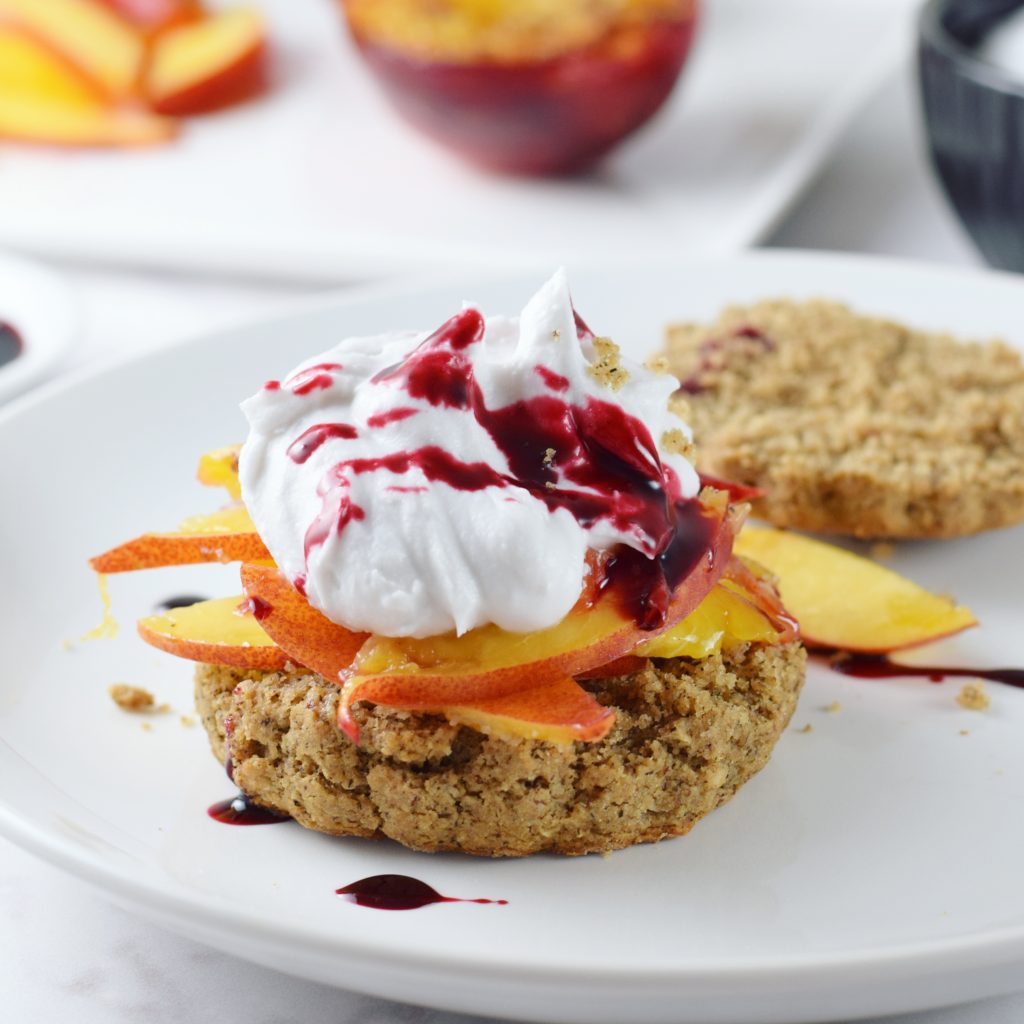
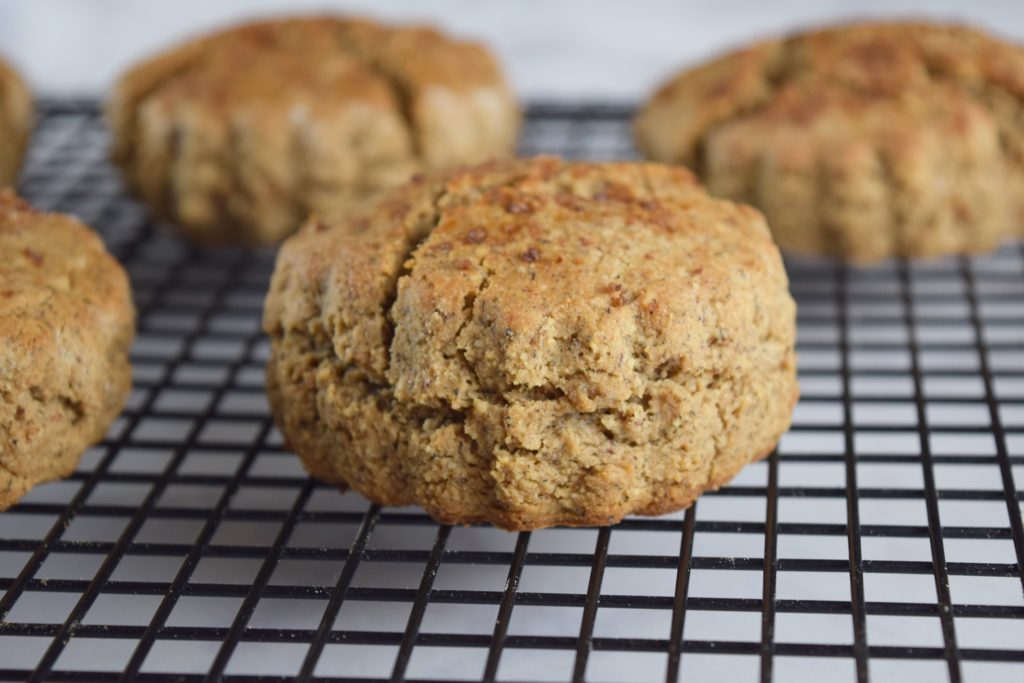
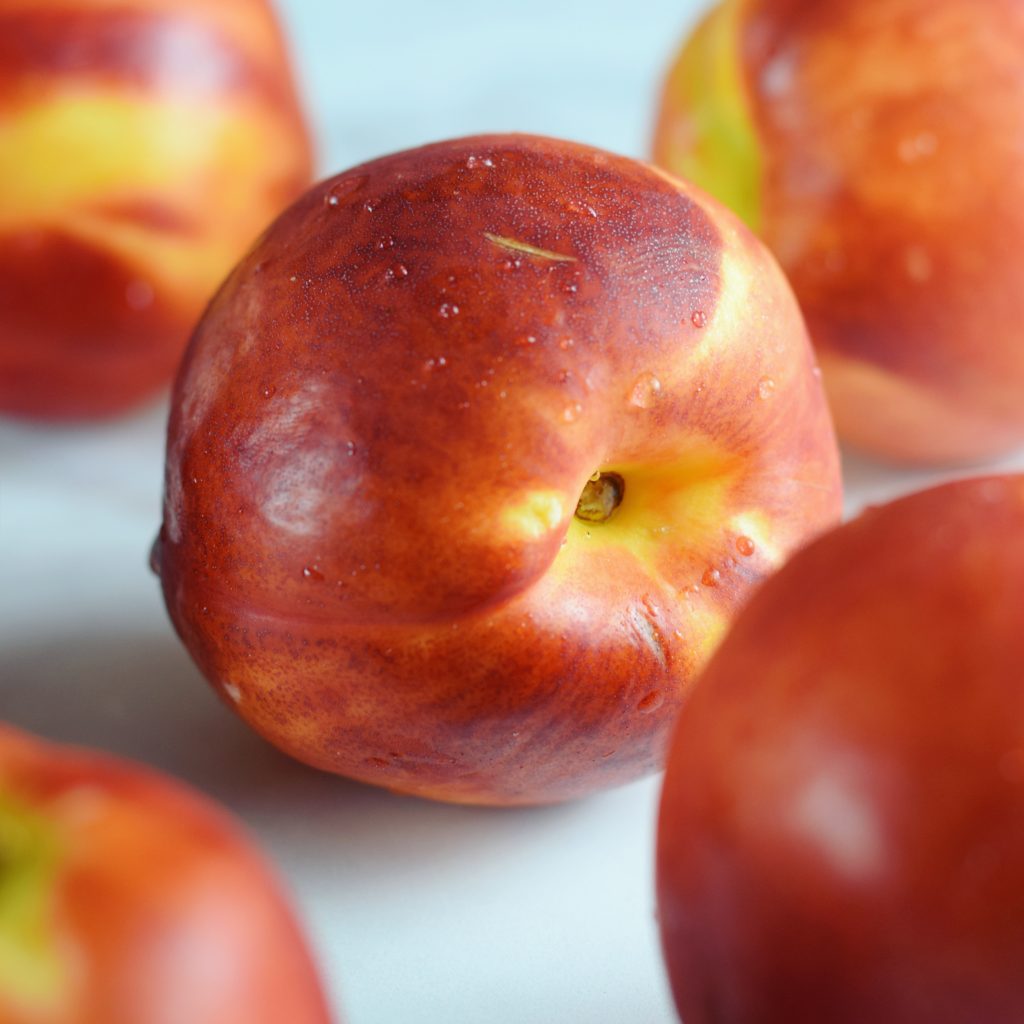
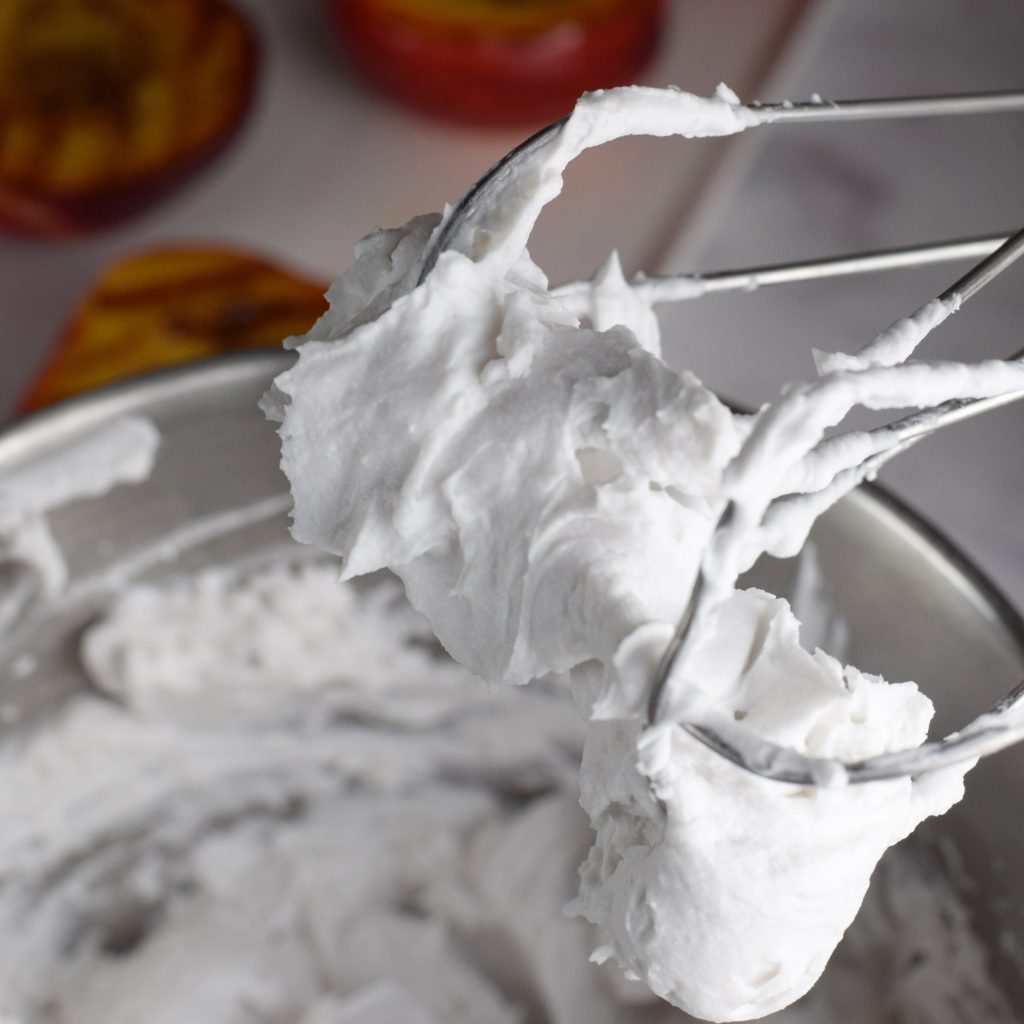
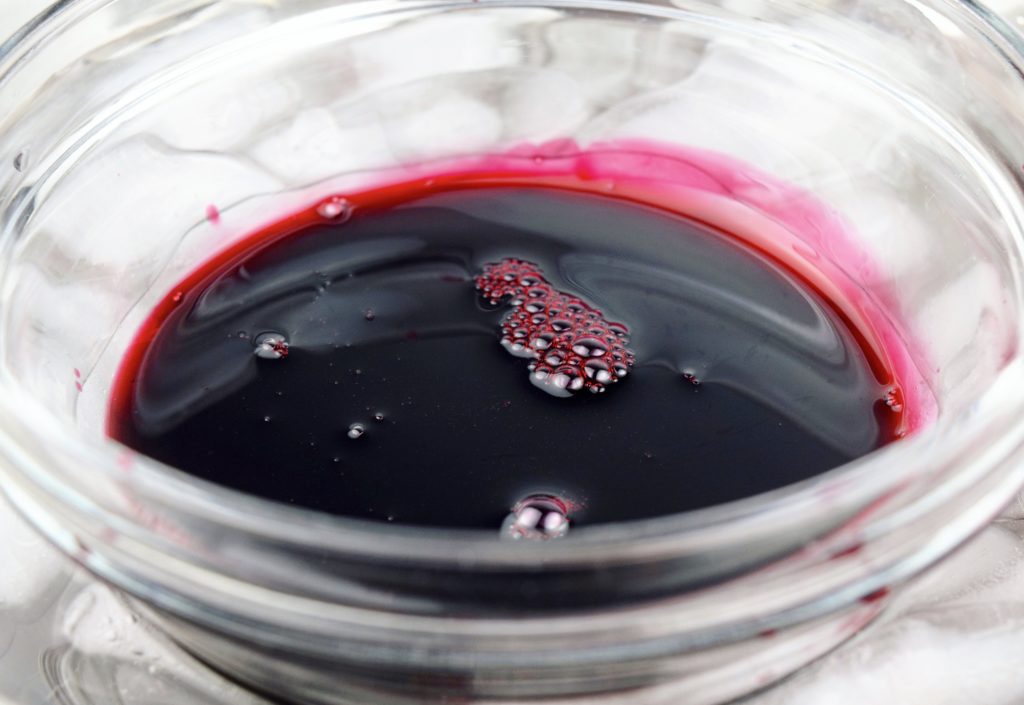
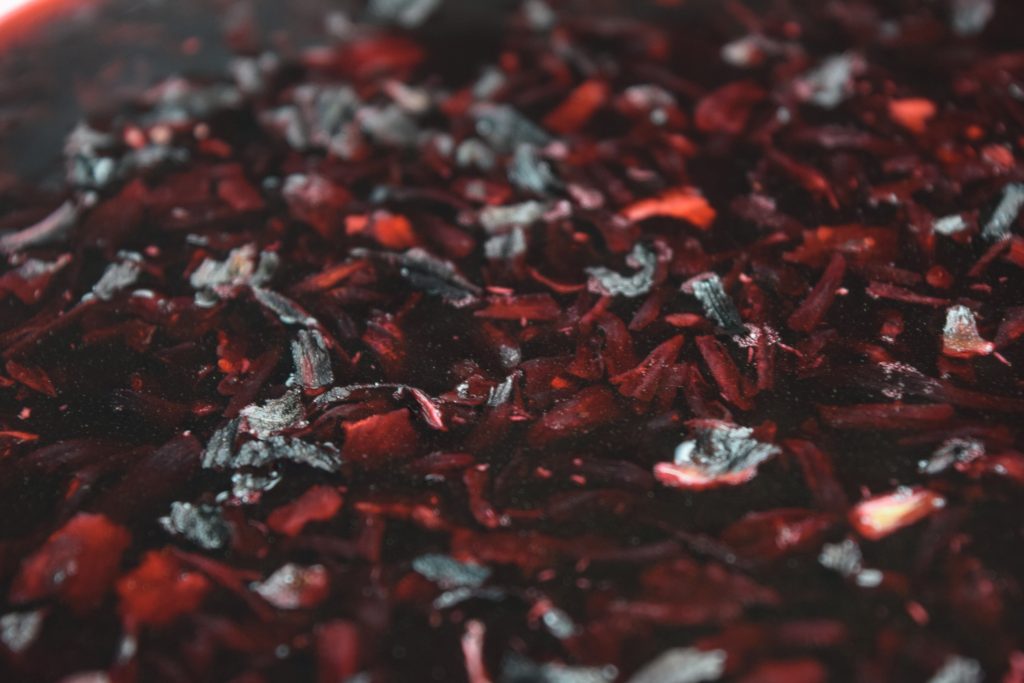
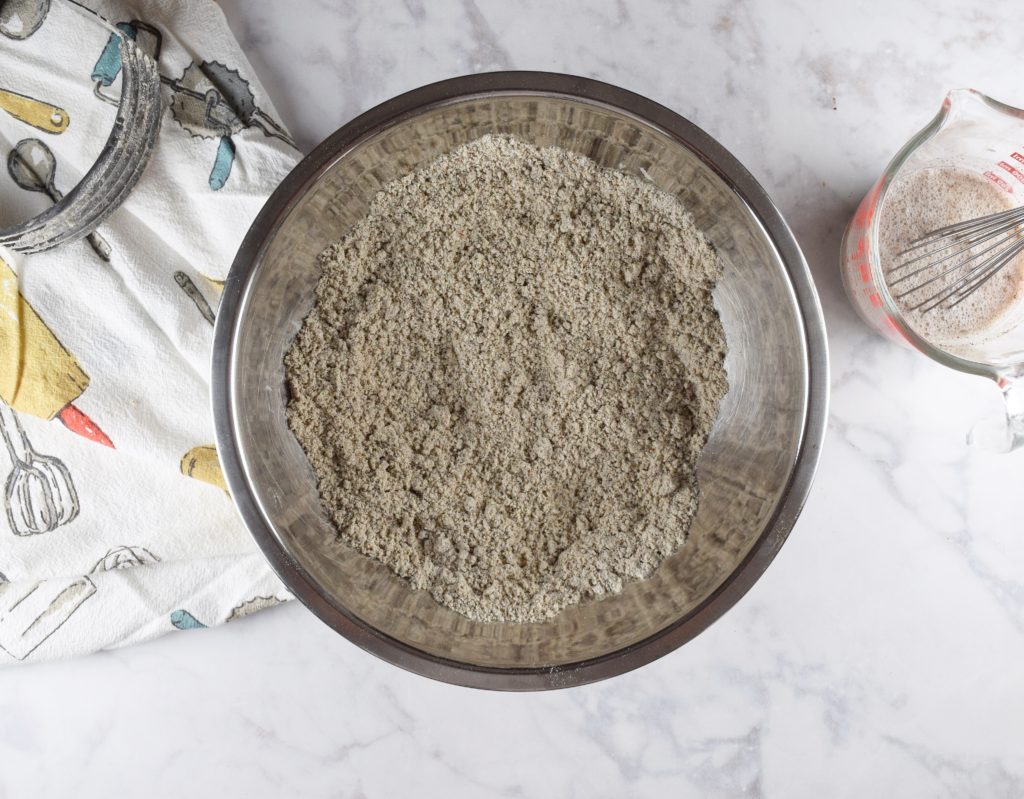
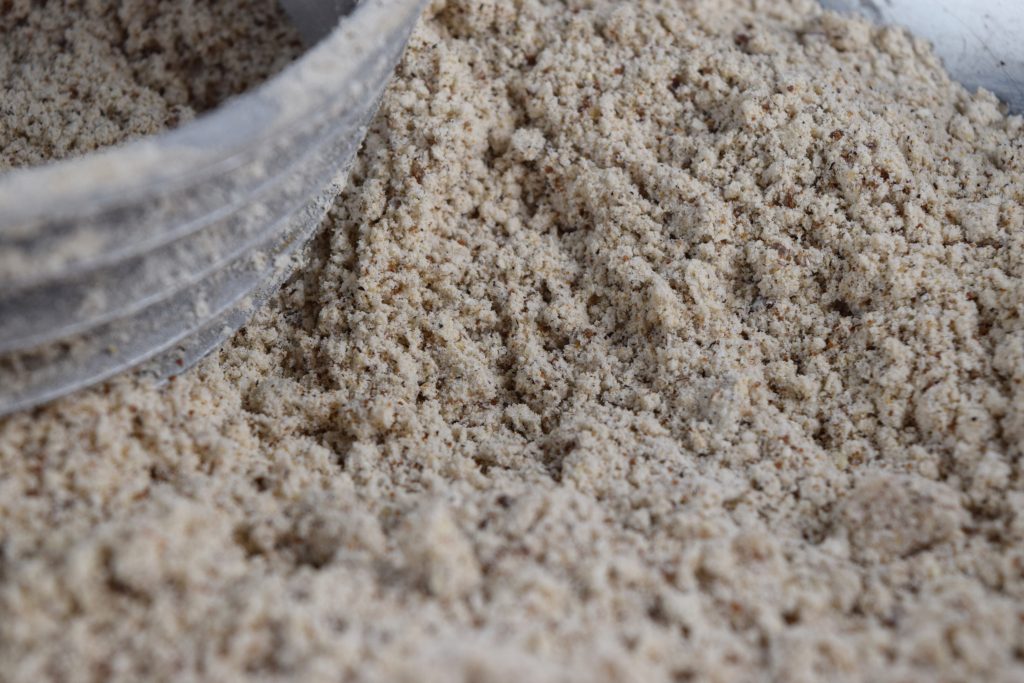
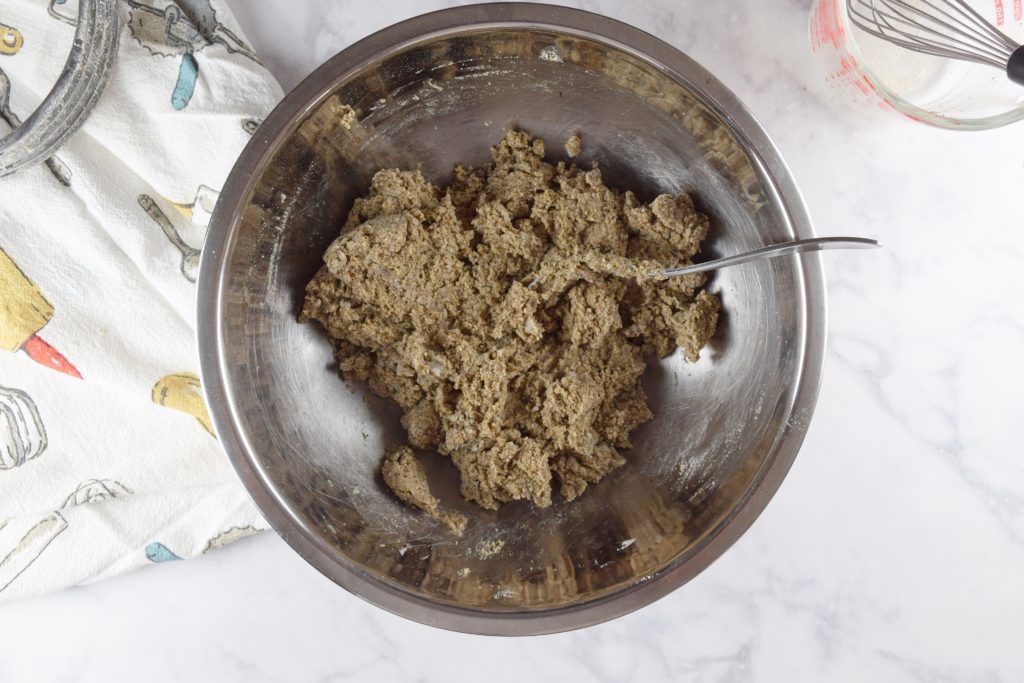
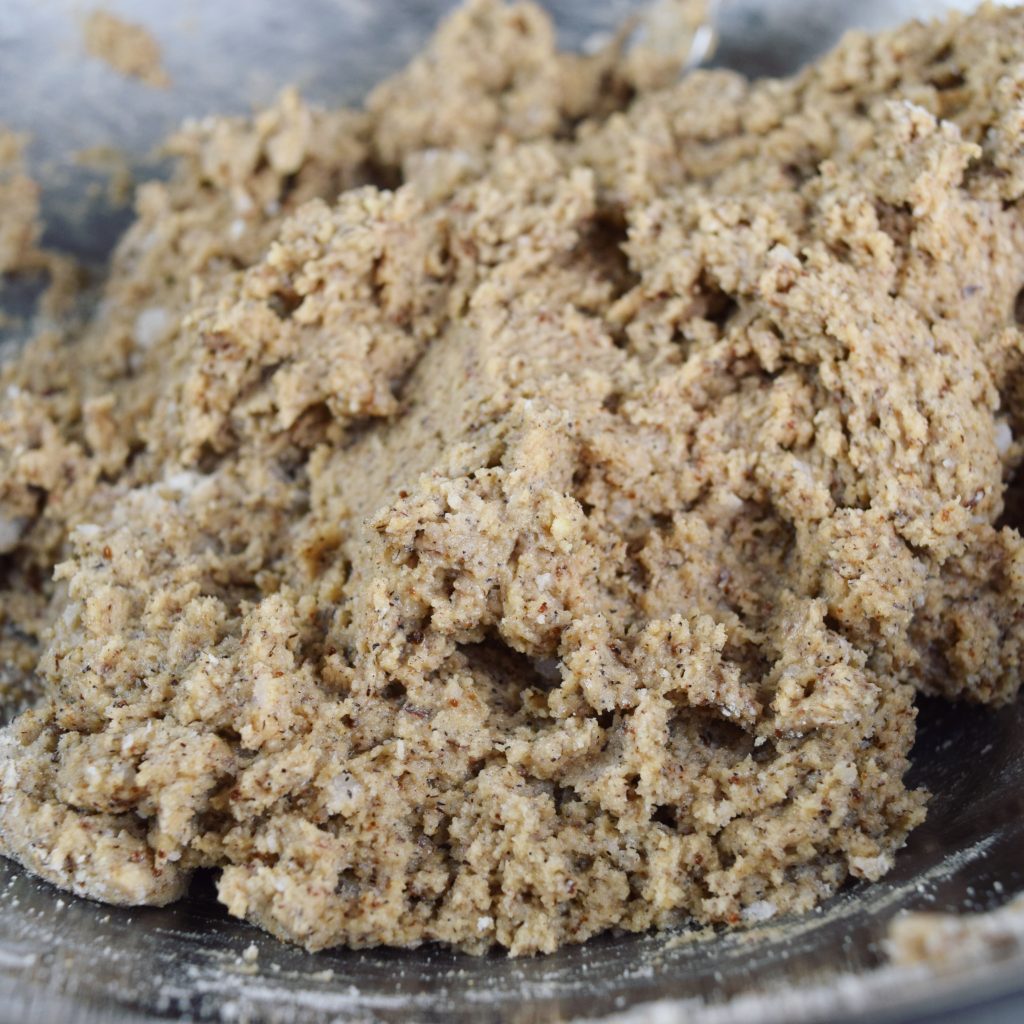
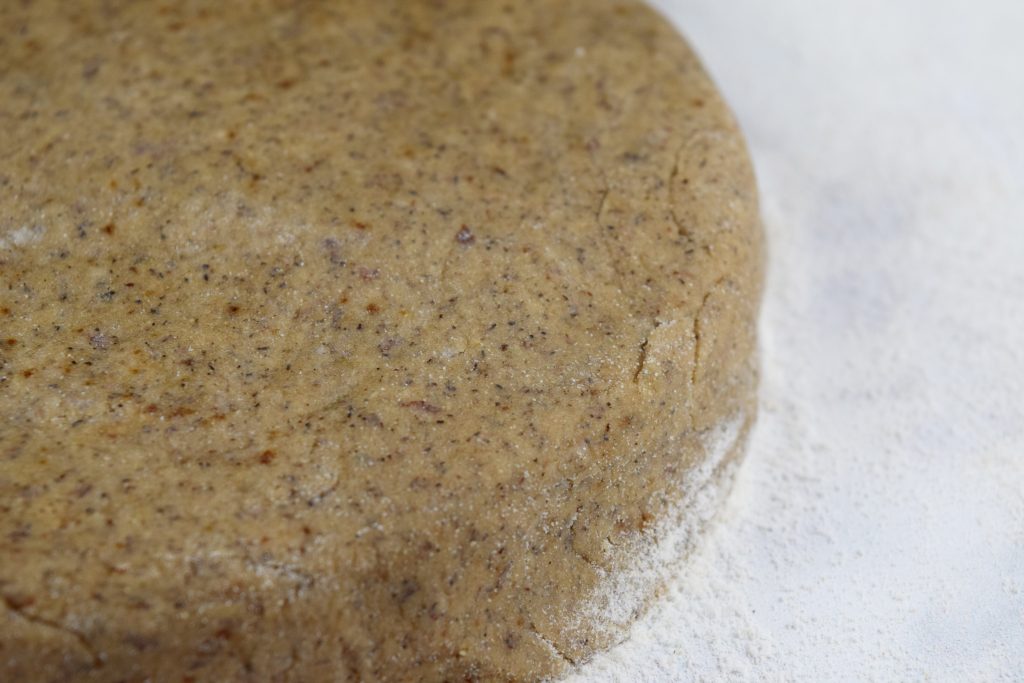
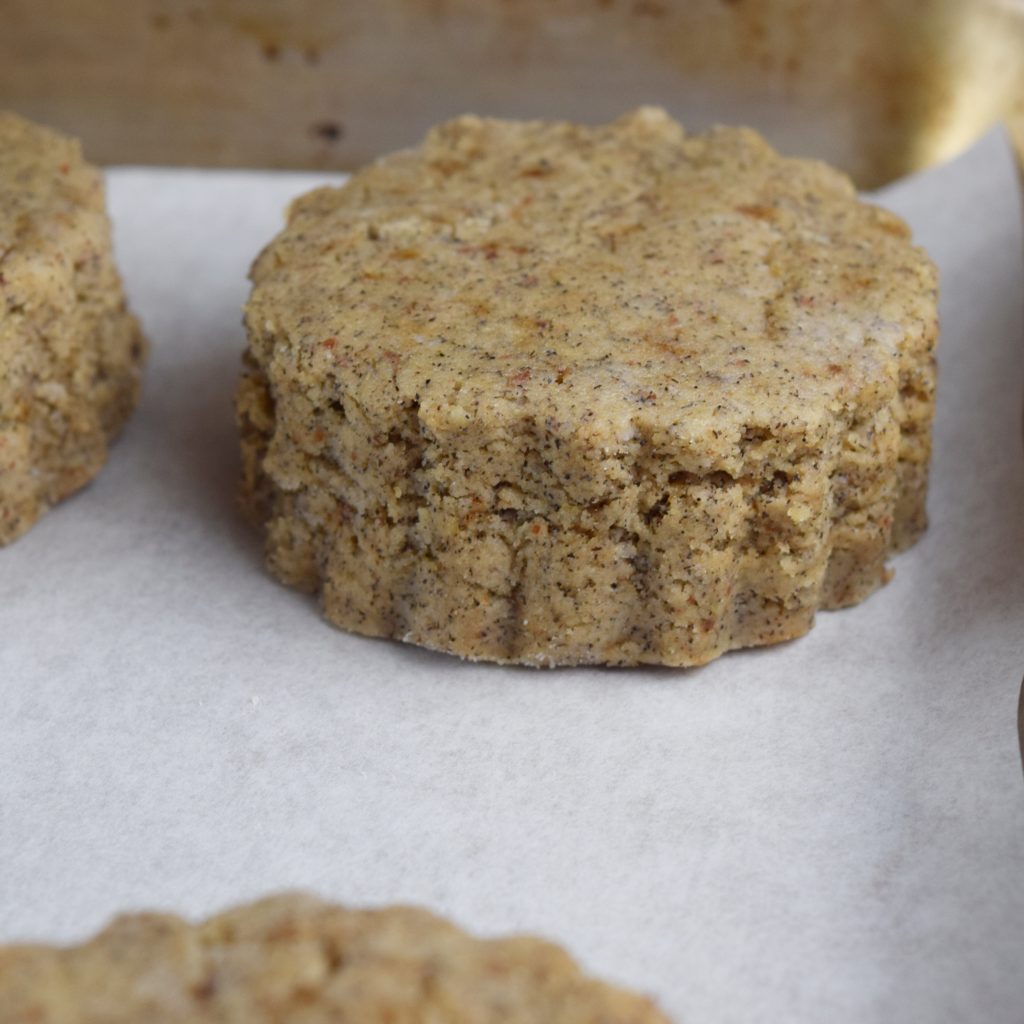

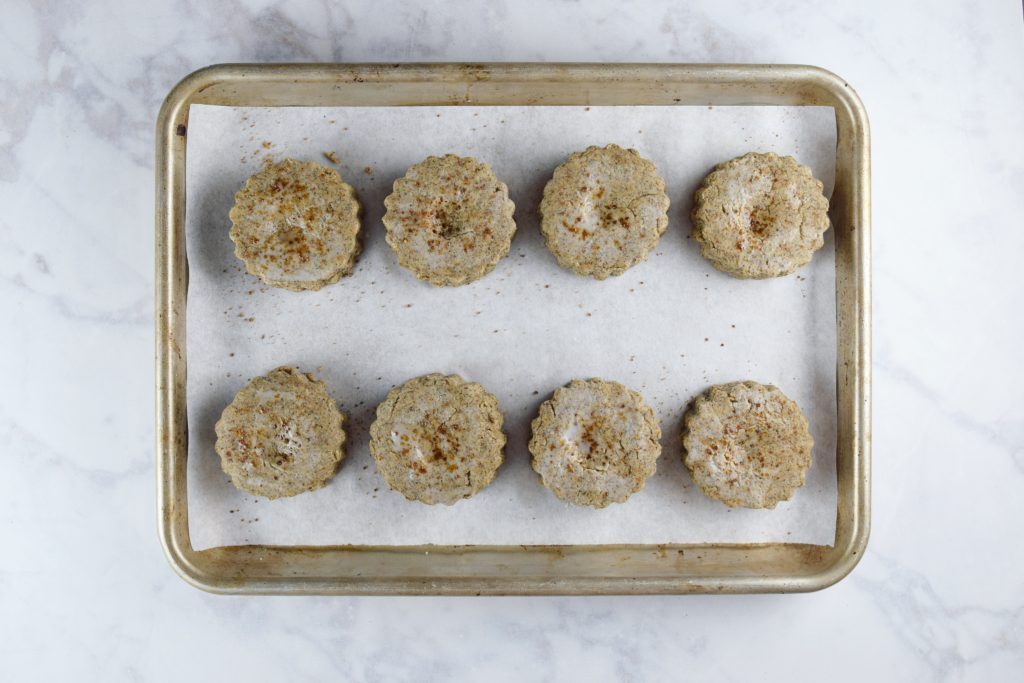
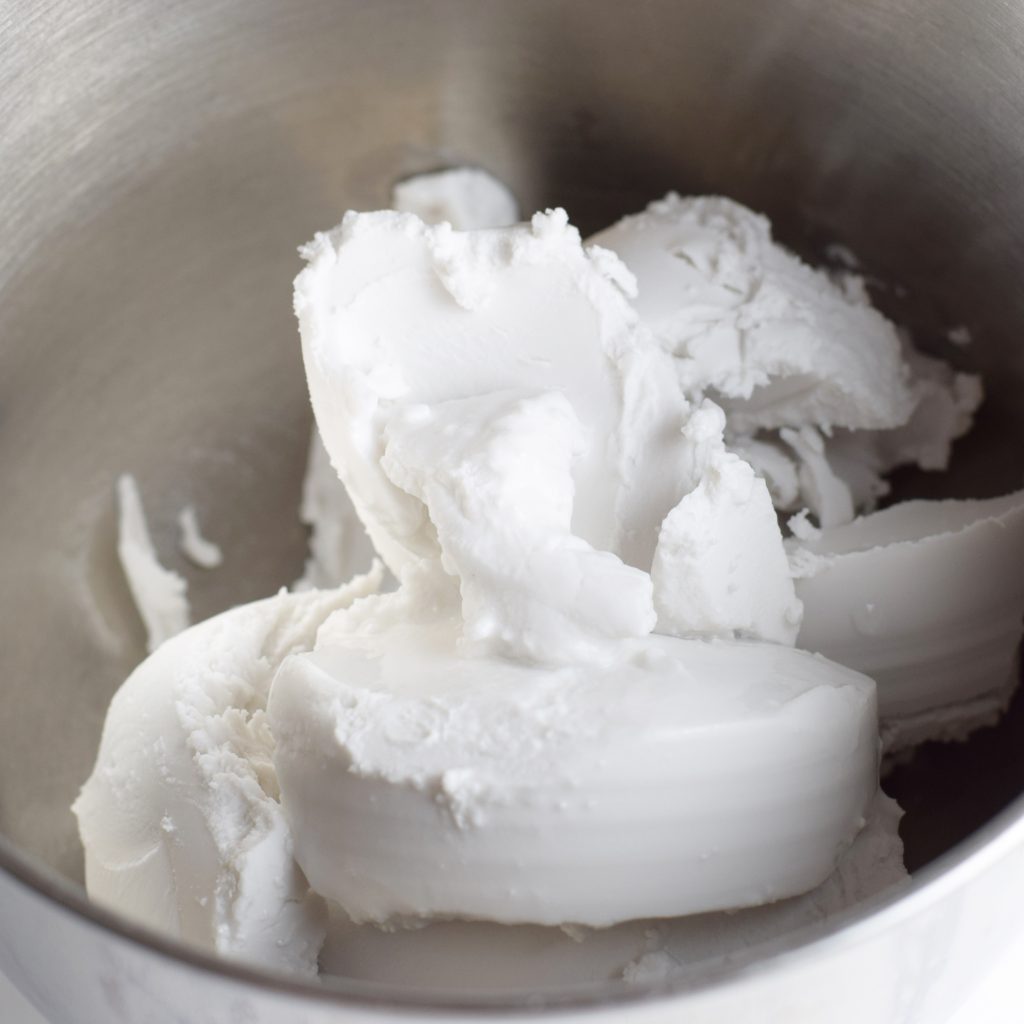
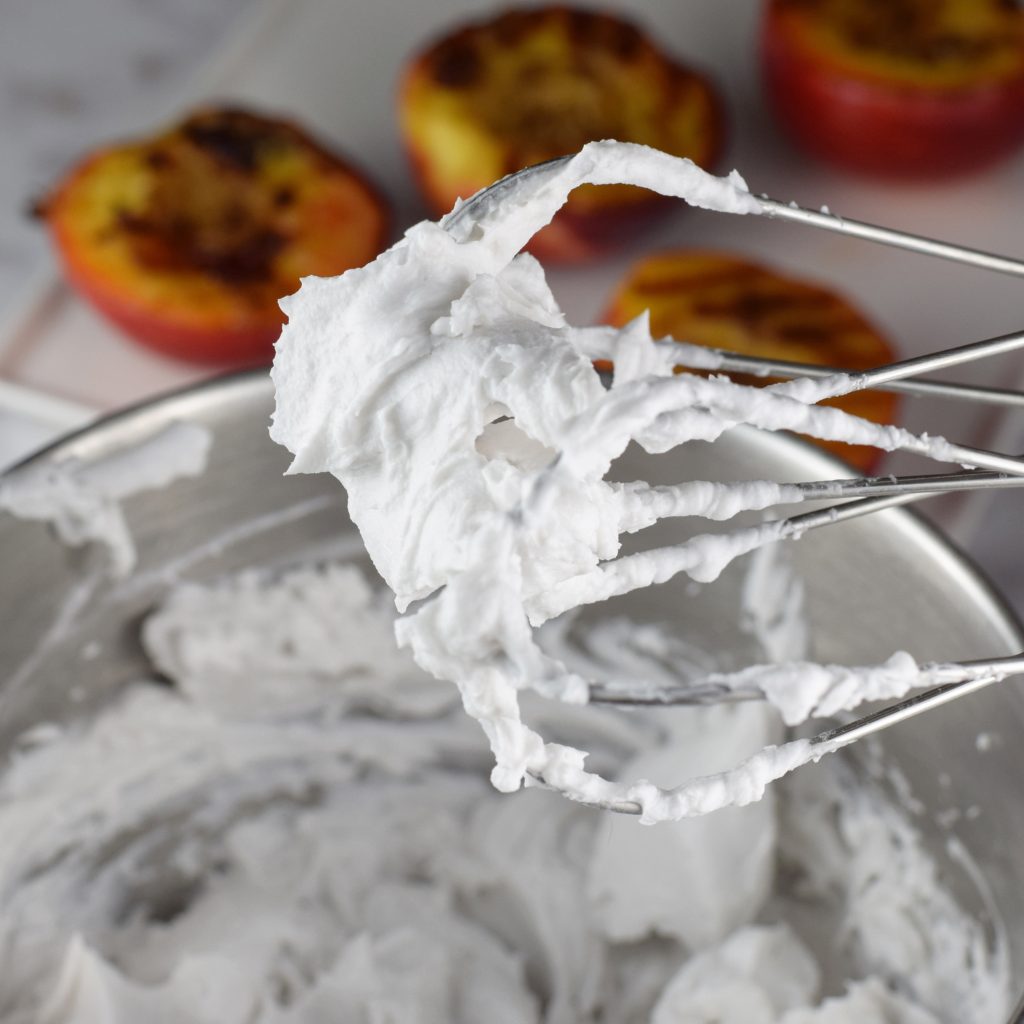
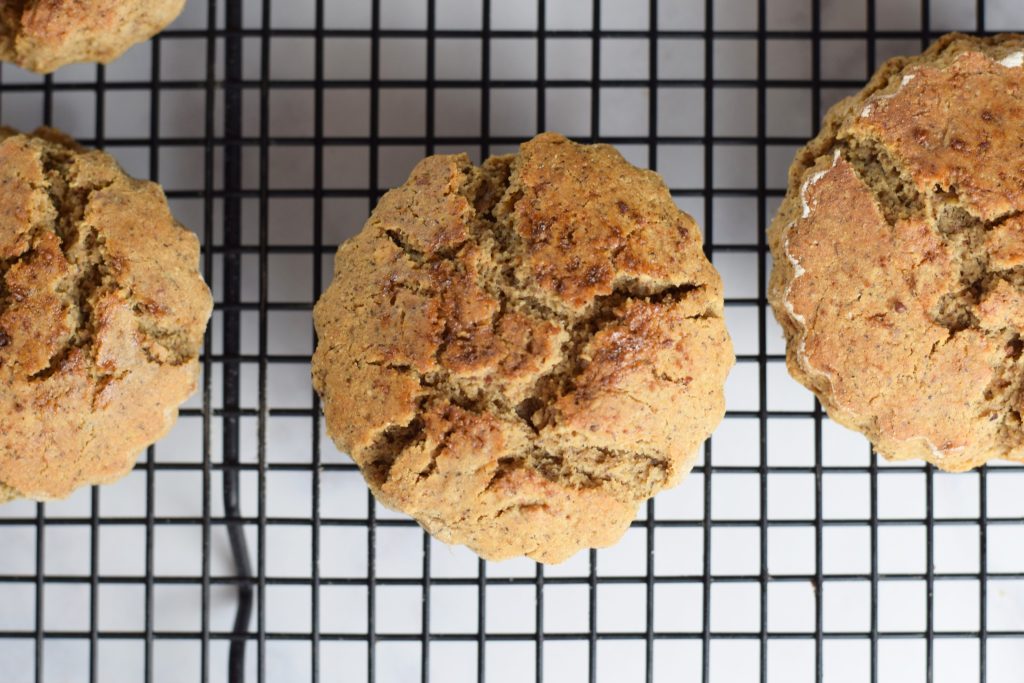
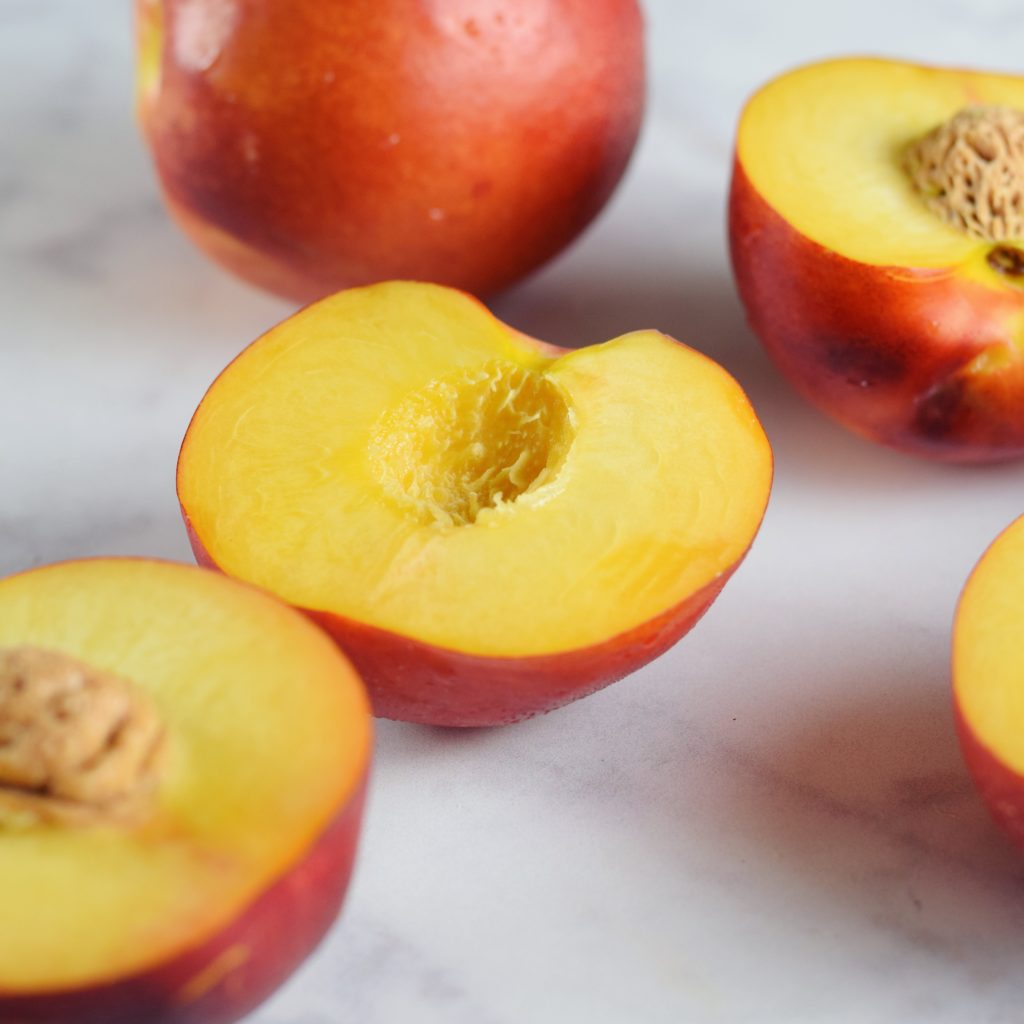
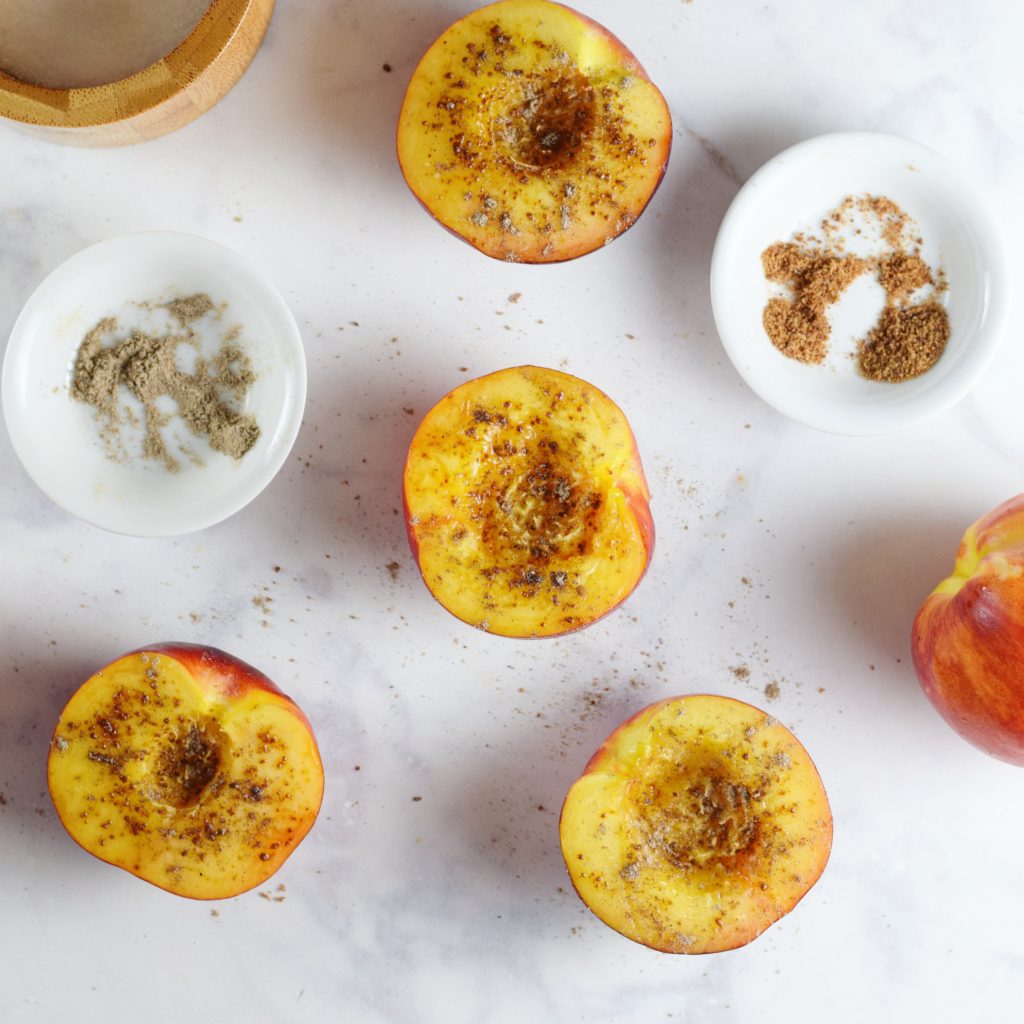
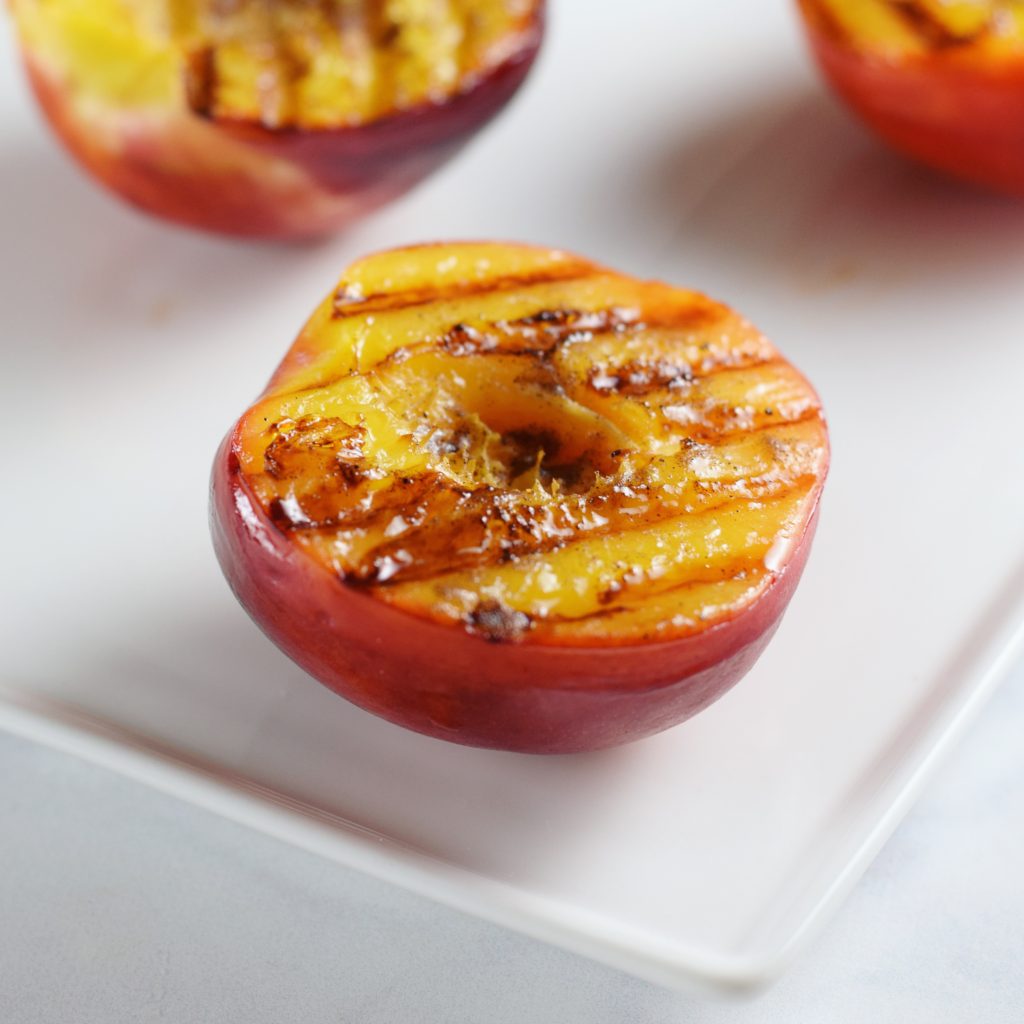
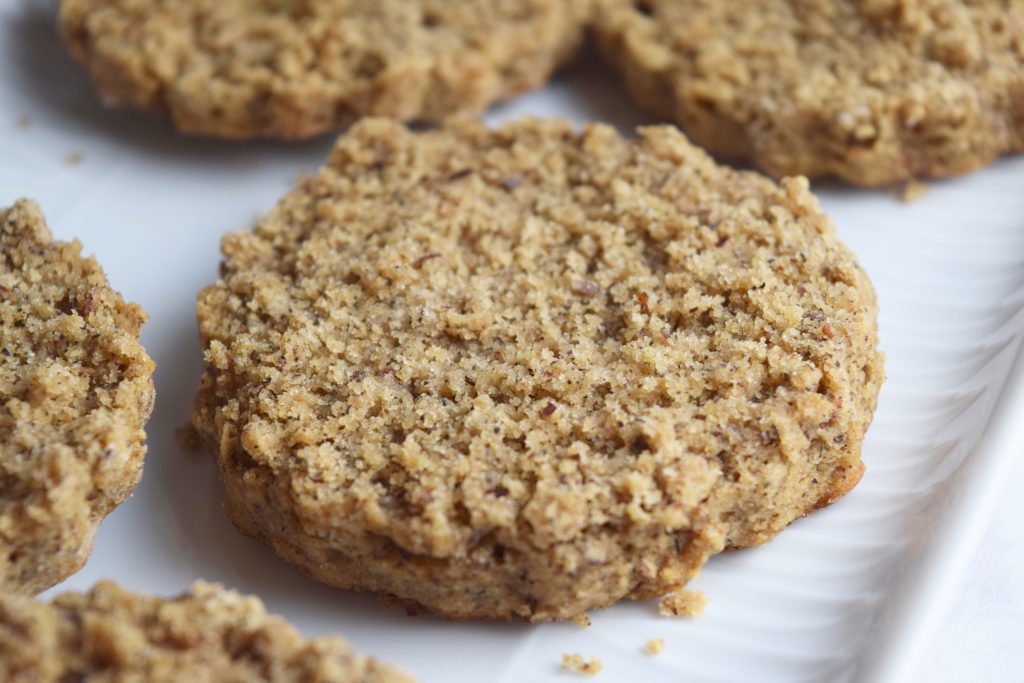
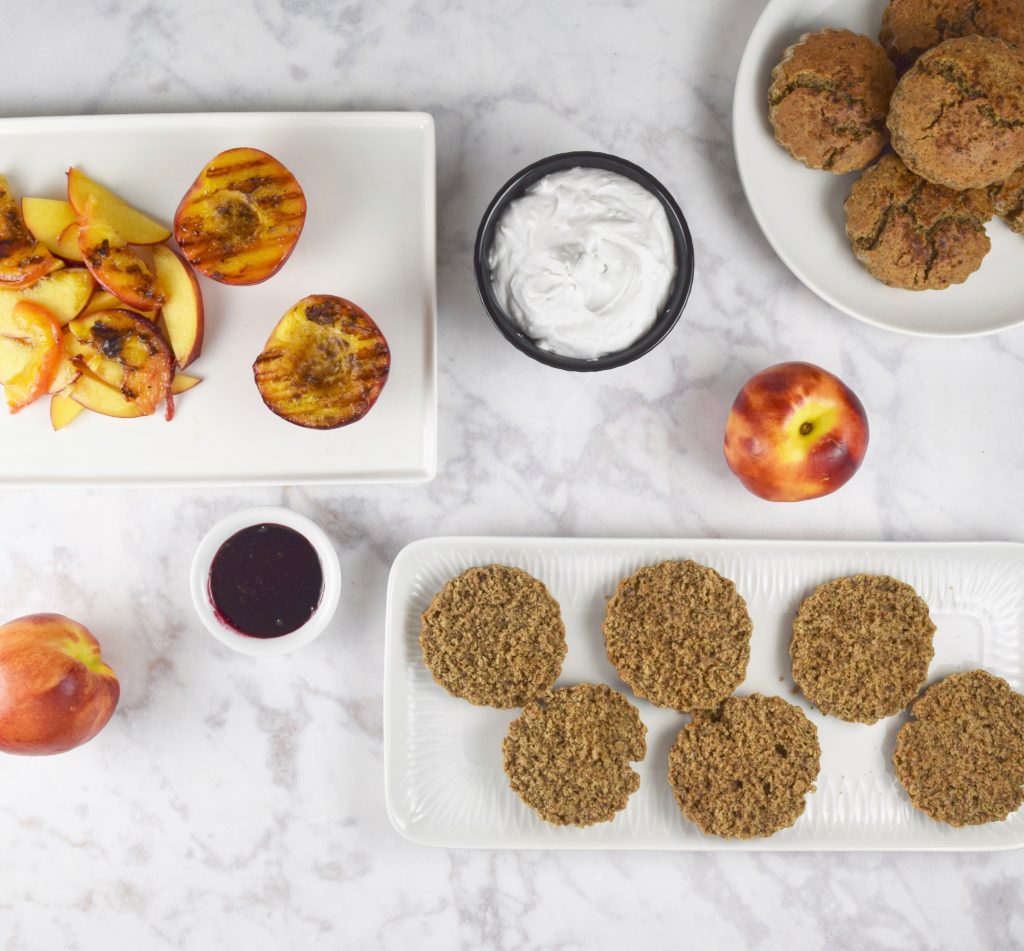
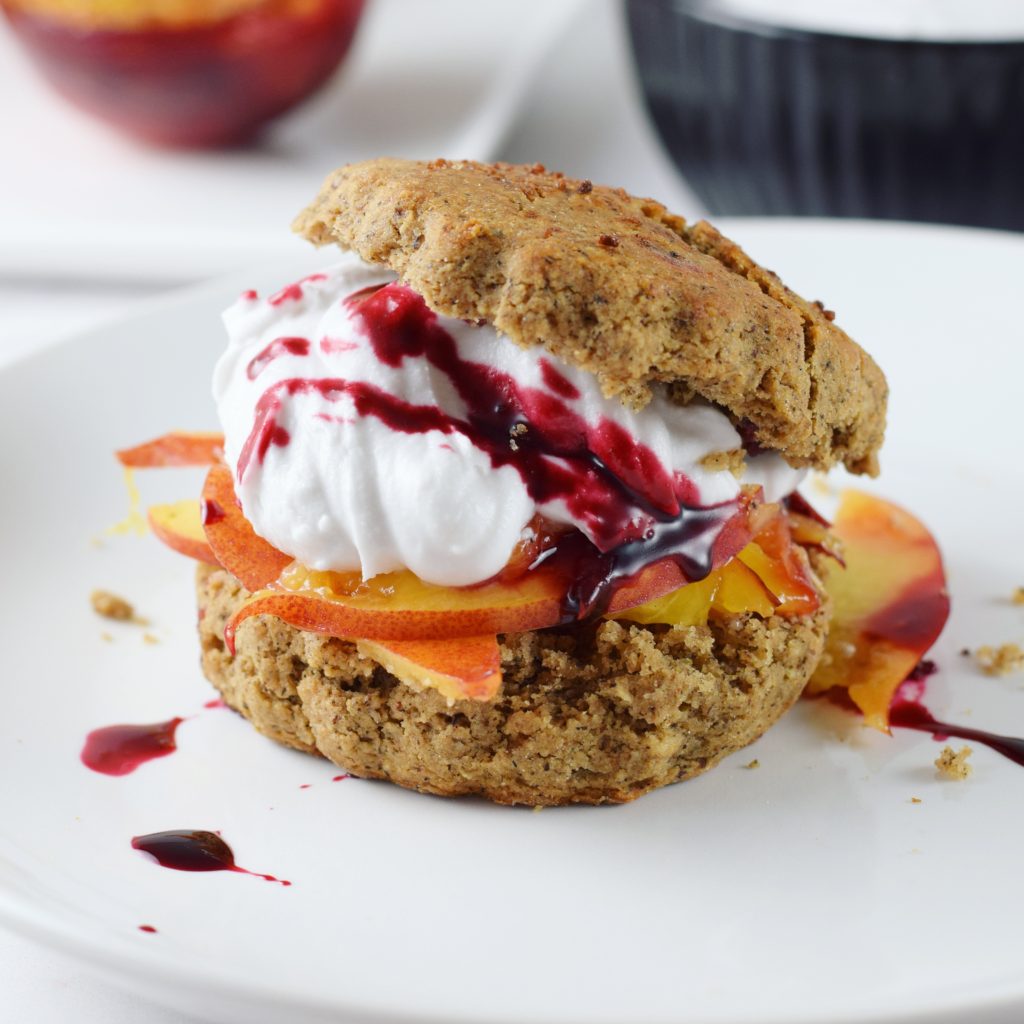

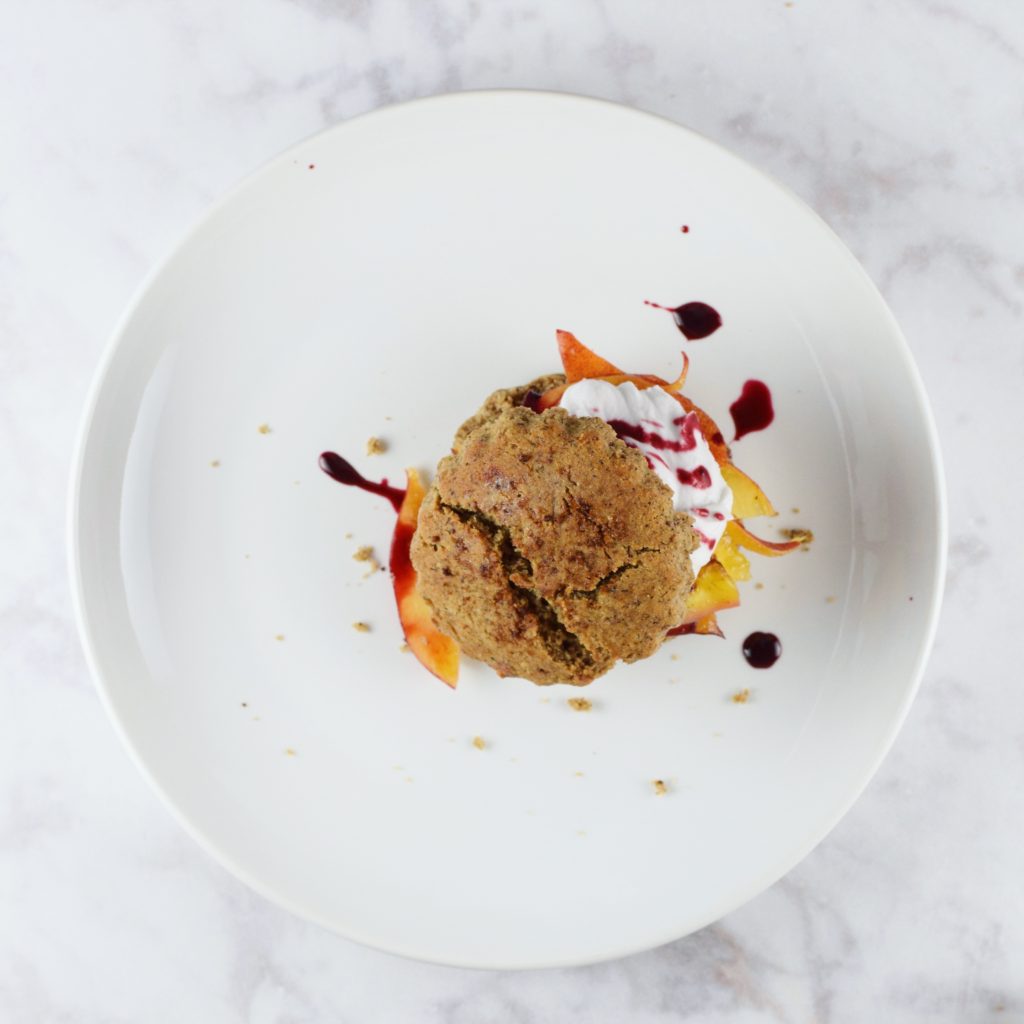
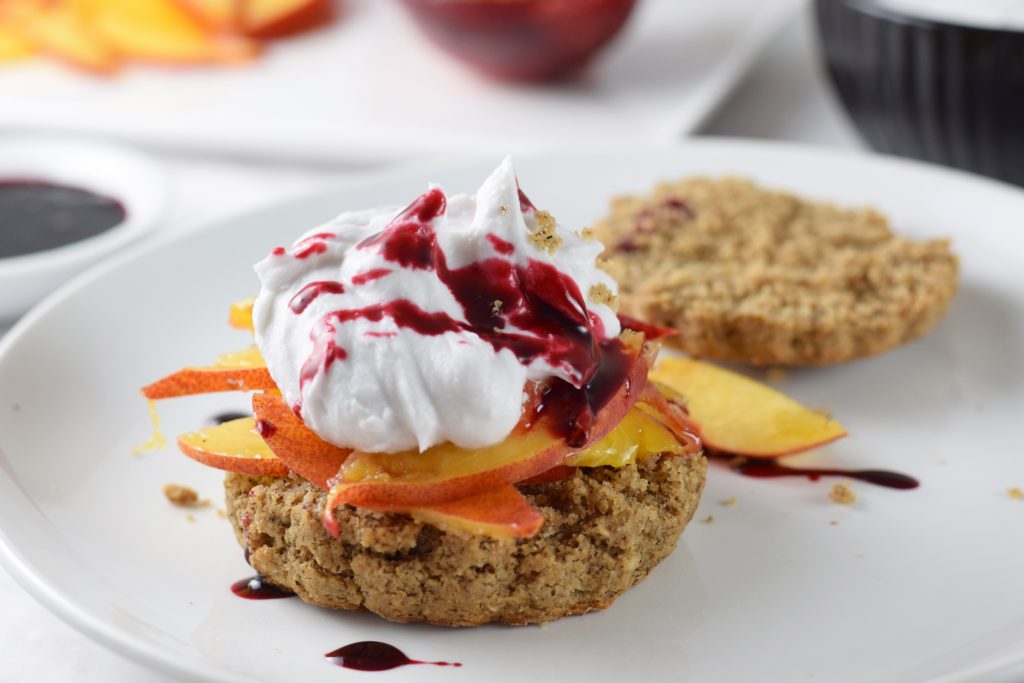


[…] of dried hibiscus. I’ve featured hibiscus here on the blog in other recipes (see here and here), and honestly if you haven’t tried baking with it yet you’re really missing out. The […]